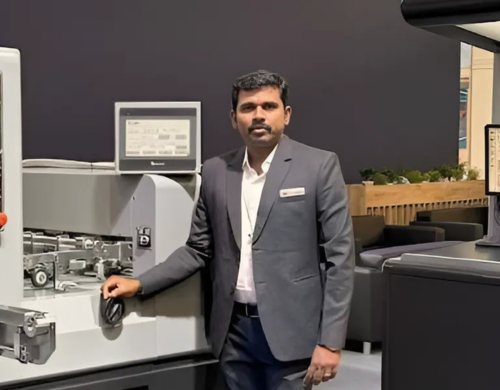Interview with Mr. Sangeeth Kumar, Managing Partner, Filigree Pack
Filigree is a renowned Die Cutting Machine Suppliers, and they specialize in its customer-focused superior engineering.
Print3 : Could you tell us more about Filigree?
Sangeeth Kumar : FILIGREE PACK established 2018 by two aggressive and energetic technocrats with fully loaded battery of knowledge and experience. We are providing below for all kinds of Die cutters, Foil stampers, Flute laminators, Window Patching and Folder Gluers.
- New machine sales
- Used machine and reconditioned machine sales
- Spare parts support Technical support / machine service Annual maintenance contracts
- Machine overhauling
- Machine re-installations
Print3 : What are the principles, mission, and vision of your company?
SK : Principles of the company: Integrity, Accountability, Trust, Respect, Team work, customer focus and Excellence.
Mission: To deliver high quality reliable cost-effective machinery with outstanding service and commitment to continuous improvement. Provide Top-notch service exceeding customer expectations
Vision: Sales expansion plan for machinery. Launching a manufacturing unit in the next 5 years. To establish service offices in all the major cities.
” As a die-cutting machine supplier in India and other packaging machines, such as hot foil stamping, automatic folder gluers, high-speed film lamination machines, etc., we are experiencing remarkable growth in the industry “
P3 : Can you explain how a high- speed die cutting machine operates in a printing workflow?
SK : High-speed die cutting machines, such as the HT760 and HT1050 models offered by Filigree Pack, operate by feeding printed sheets into a die station where a die applies pressure to cut or crease the material. These machines are designed to handle large volumes efficiently, ensuring precise cuts and high throughput, which is essential in commercial printing operations.
P3 : What is the role and advantage of a stripping system in a die cutting machine used with printed materials?
SK : The stripping system in die cutting machines automates the removal of waste material from the cut sheets. This feature enhances productivity by reducing manual labour, increase the productivity time, and ensures cleaner outputs, which is particularly beneficial in high-volume printing environments.
P3 : How does a pneumatic locking mechanism on the cutting chase benefit die cutting operations?
SK : A pneumatic locking mechanism securely holds the cutting die in place during operation. This system allows for quick and precise die changes, reducing downtime and ensuring consistent cutting accuracy, which is crucial for maintaining quality in printed materials.
P3 : What types and thicknesses of printed materials can modern die cutting machines typically handle?
SK : Modern die cutting machines, like those offered by Filigree Pack, can handle a variety of printed materials, including paper, cardboard, laminated sheets and corrugated boards. The specific thickness capacity can vary depending on the machine model and configuration.
P3 : How does the gripper bar system contribute to maintaining precision during high-speed die cutting?
SK : The gripper bar system ensures that each sheet is securely held and accurately positioned as it moves through the die cutting station. This mechanism is vital for maintaining alignment and registration, especially during high-speed operations where even minor misalignments can lead to defects.
P3 : How is die cutting integrated into printing workflows for products like printed sheets or labels?
SK : Die cutting is typically a post- printing process where printed sheets or labels are fed into the die cutting machine to achieve specific shapes or creases. This integration ensures that the final product meets design specifications and is ready for subsequent processes like folding, gluing, or packaging.
P3 : Why is die cutting considered a post-printing process in the print production chain?
SK : Die cutting is considered a post-printing process because it involves shaping or creasing the printed material after the ink has dried. This sequencing ensures that the printed images are not disturbed and that the final product maintains its integrity and quality.
P3: What pre-checks should be made on printed sheets before they enter a die cutting machine?
SK : Before feeding printed sheets into a die cutting machine, it’s essential to check for proper registration, ensure the ink is fully dried, and verify that the sheets are flat and free from defects. These checks help prevent jams and ensure high-quality outputs.
P3 : What routine maintenance practices are necessary to keep a die cutting machine performing well with printed materials?
SK : Routine maintenance includes cleaning and lubricating moving parts, inspecting and replacing worn components, calibrating the die cutting system, and ensuring that the pneumatic and electrical systems are functioning correctly. Regular maintenance helps extend the machine’s lifespan and maintain consistent performance.
P3 : Please describe a challenge you faced with sheet misalignment during die cutting and how you addressed it.
SK : One common challenge is sheet misalignment, which can lead to inaccurate cuts. This issue can be addressed by adjusting the feeder system, calibrating the gripper bars, and ensuring that the die is properly aligned. Regular maintenance and setup checks are crucial in preventing such issues.
P3 : How do continuous feeding and delivery systems improve efficiency in die cutting operations?
SK : Continuous feeding and delivery systems, such as those found in Filigree Pack’s machines, allow for uninterrupted operation by automatically feeding sheets into the machine and delivering finished products without manual intervention. This automation reduces labour costs and increases throughput.
P3 : What purpose does an air-floating die-cutting plate serve on modern die cutting machines?
SK : An air-floating die-cutting plate uses a cushion of air to support the plate, making it easier to handle and position. This feature reduces the risk of damage to both the cutting plate and the machine, enhances safety, and simplifies the setup process.
P3 : Challenges & Competitions you are facing in the market?
SK : Maintaining consistent service quality, managing customer expectations, fulfilling demands, handling complaints and negative feedback, cost control.



